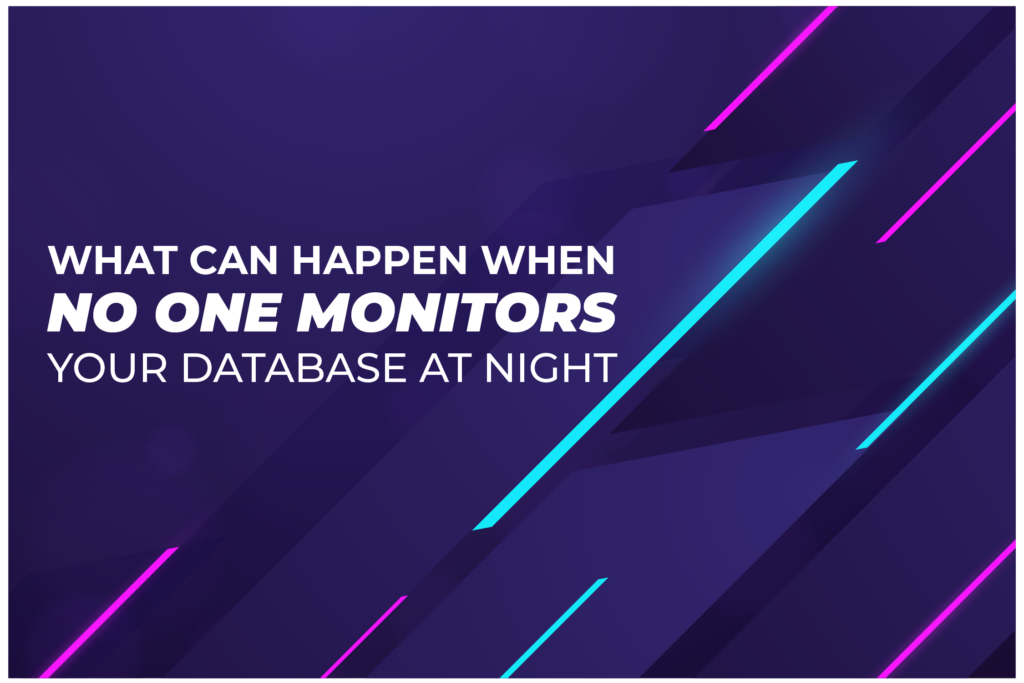

Most IT teams operate under a dangerous and deeply flawed premise: that their systems’ “night shift” is a period of low activity and, therefore, low risk. The reality, however, is the exact opposite. It is during the night, away from the eyes and monitoring of the operations team, that the heaviest, most critical, and most dangerous processes are executed.
It is the silent shift where vital backups are performed, where terabytes of data are moved in ETL processes to feed the next day’s business intelligence, and where systems, in their apparent calm, are most vulnerable to discreet attacks and silent degradation.
Leaving these processes without intelligent surveillance is like leaving the bank vault open, trusting that a generic motion alarm—which may not even trigger for a subtle threat—is enough to ensure security. The real problem isn’t the catastrophic failure that triggers a red alert; it’s the silent failure, the subtle degradation that goes unnoticed. When the team arrives in the morning and finds an inexplicably slow system or, worse, an inconsistent BI report, the damage has already been done.
The day’s work doesn’t start with innovation, but with a frustrating forensic investigation to find out what went wrong in the dark—a ghost hunt that drains the team’s productivity and morale.
The Anatomy of the Silent Shift: The Critical Operations No One Sees
While your team rests, your database is working hard on tasks that are the backbone of business continuity and strategic decision-making. The failure, or even simple inefficiency, in any of them has a cascading effect that ripples throughout the entire organization.
Backup Routines: The Insurance Policy No One Checks
The backup is your last line of defense against a disaster, whether it’s a hardware failure, human error, or a ransomware attack. However, a “green check” in a backup log can create a dangerous false sense of security. Without behavioral surveillance, critical problems can go unnoticed:
- Resource Contention: A heavy backup can compete for disk I/O with other nightly routines, like an ETL, degrading the performance of both and, in extreme cases, causing neither to finish on time.
- Incomplete or Corrupted Backups: The job might “finish successfully” but have failed to copy a crucial data file due to a lock or a transient permission issue. This will only be discovered at the worst possible moment: during a restoration attempt.
- Backup Window Degradation: As data grows, the time required for the backup increases. If this degradation is not monitored, the backup window can start to creep into business hours, impacting system performance for the first users of the day.
ETL Processes and the Integrity of Business Intelligence
The heart of your Business Intelligence (BI) and Data Science strategy depends on the Extract, Transform, and Load (ETL) processes that run overnight. They are responsible for populating the Data Warehouse with the previous day’s data. A failure here poisons decision-making across the entire company.
- The “Data Hangover”: If an ETL fails or is delayed, management, marketing analysts, and sales teams will start the day making decisions based on data from the day before yesterday. In a dynamic market, this is the equivalent of navigating by looking in the rearview mirror.
- Silent Data Corruption: Worse than a lack of data is having wrong data. An ETL that fails halfway through can leave the Data Warehouse in an inconsistent state. The BI dashboards might still work, but the numbers they show are fundamentally incorrect, leading to flawed business conclusions and strategies.
The Double-Edged Sword of Nightly Maintenance
Maintenance routines like index rebuilds, statistics updates, and data archiving are essential for database health. However, when poorly managed or unmonitored, they can cause more problems than they solve.
- Excessive Locking and Blocking: An index rebuild on a large table can place aggressive locks that block other nightly routines, creating a process gridlock that can paralyze the environment.
- Stale or Incorrect Statistics: The database’s query optimizer depends on accurate statistics to choose the most efficient execution plan. A statistics update routine that fails or is interrupted can leave the optimizer “blind,” leading it to choose terrible plans that cause the mysterious slowness of the following morning.
The Window of Opportunity for Security Threats
The night is prime time for cyber-attackers. They know that human surveillance is minimal and that response time is slow. They exploit this window to carry out activities that would be too “noisy” during the day.
- Reconnaissance and Lateral Movement: Attackers use the night to explore the database structure, test permissions, and identify where the most valuable data is stored.
- Slow and Discreet Data Exfiltration: Instead of a massive SELECT * that would trigger an alarm, attackers execute thousands of small queries over hours, exfiltrating data “homeopathically” to stay below the radar of traditional monitoring tools.

The Cascade Effect: How Nightly Failures Poison Daytime Productivity
The biggest problem with nightly failures is not the event itself, but its silent consequences that manifest hours later, turning the start of the IT team’s day into an exercise in frustration and wasted time.
The Mystery of Database Morning Slowness: Hunting for Performance Ghosts
The scenario is classic: the team arrives at 9 a.m. and the system is inexplicably slow. CPU and memory dashboards are normal. What happened? The root cause is buried in the events of the previous night: an index fragmented by a failed maintenance routine, statistics that weren’t updated on a table that grew significantly, or residual I/O contention from a backup that competed with an ETL. Without deep visibility into what happened during the night, the team loses precious hours on a ghost hunt, while the entire company’s productivity is impacted.
Silent Data Corruption and the Erosion of Trust
Perhaps the most dangerous effect is the erosion of trust in the data. When the marketing team realizes that the morning’s sales report is inconsistent with what they see in the transactional system, trust in the entire BI platform is shaken. This distrust spreads, and soon managers start questioning every number, forcing analysts to spend more time validating data than extracting insights from it. The company becomes slower, more cautious, and less competitive, all because of an ETL that failed silently at 3 a.m.
dbsnOOp: Illuminating the Night Shift with the Autonomous DBA
The answer to this complex challenge is not to have a DBA staring at screens all night. It is to have an Artificial Intelligence performing the analysis that no human could in real time, 24 hours a day. The Autonomous DBA from dbsnOOp was designed to be the intelligent, analytical, and proactive guardian of your silent shift.
Behavioral Surveillance, Not Just Thresholds
Forget static alerts like “CPU > 90%.” dbsnOOp’s AI creates a behavioral baseline for your nightly processes, learning over time. It knows how long your backup usually takes on a Tuesday, what resources your end-of-month ETL normally consumes, and which queries are standard for your weekend maintenance routines. Surveillance is focused on anomalies and statistical deviations:
- “This Sunday’s ETL process consumed 50% more I/O than the average of the last 10 Sundays. This is a significant deviation that needs attention.”
- “The index rebuild query is generating a 5-minute lock wait, a behavior never before observed for this job.”
- “The volume of data read by a service user at 4 a.m. is 3 standard deviations above their normal activity, indicating a possible data exfiltration.”
Root Cause Diagnosis for Silent Failures with the Top-Down Approach
When dbsnOOp detects an anomaly in a nightly job, it doesn’t send a vague alert. It performs a complete and automatic Top-Down Diagnosis, one of its core features. If your ETL is slow, the platform will detail in seconds:
- The System Layer: Identifies contention at the operating system level (e.g., high iowait, indicating a disk bottleneck).
- The Database Layer: Correlates this contention with the exact database session running the ETL process.
- The Application Layer: Pinpoints the specific SQL query within your ETL script that is causing the bottleneck.
- The Fundamental Cause: Analyzes the query’s execution plan, revealing whether the cause is a missing index, stale statistics, or a fundamental change in data volume.
What would take a human DBA hours to investigate manually is presented clearly and actionably on a single dashboard.
From Morning Reaction to Continuous Improvement: The Optimization Dossier
The result of this intelligent nightly surveillance is a fundamental shift in your IT team’s dynamics. Instead of arriving in the morning to fight a mysterious fire, they find an intelligence report. The platform presents a prioritized optimization dossier, detailing the deviations, causes, and correction recommendations. The nightly problem turns into a daytime improvement opportunity.
The SRE and DBA team can use their time to strengthen the system’s architecture and implement the suggested optimizations, instead of wasting the entire morning on reactive investigations. The AI handles the surveillance and diagnosis, allowing your experts to focus on execution and strategy.
Your systems don’t take a day off. The intelligence that protects them shouldn’t either.
Want to solve this challenge intelligently? Schedule a meeting with our specialist or watch a live demo!
Schedule a demo here.
Learn more about dbsnOOp!
Learn about database monitoring with advanced tools here.
Visit our YouTube channel to learn about the platform and watch tutorials.

Recommended Reading
- What is query degradation and why does it happen?: Many of the nightly failures and slowdowns are a direct result of query degradation in batch and ETL processes. This article provides the essential technical context to understand the root cause of many of the silent problems that dbsnOOp detects overnight.
- When are indexes a problem?: Nightly maintenance routines, such as index rebuilds, can be the cause of the problem rather than the solution. This post delves into how poorly planned or corrupted indexes can degrade performance, a scenario that the Autonomous DBA’s 24/7 surveillance is designed to identify and diagnose.
- 24/7 monitoring of databases, applications, and servers: This article expands the argument for a holistic view. A problem in your nightly ETL might not be in the database, but in a communication failure with the application server. It reinforces the value of dbsnOOp’s Top-Down approach, which analyzes all layers to provide a precise diagnosis, no matter the origin of the failure.

